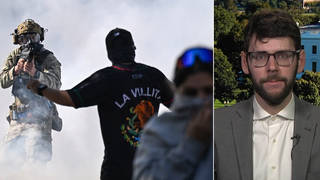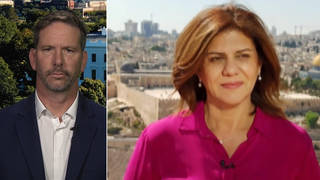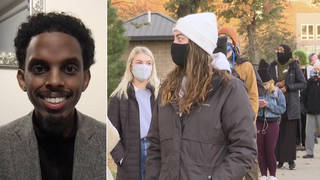
Guests
- Isabel WilkersonPulitzer Prize-winning journalist and winner of the National Humanities Medal.
In her extensively researched new book, “Caste: The Origins of Our Discontents,” Pulitzer Prize-winning journalist Isabel Wilkerson argues the United States’ racial hierarchy should be thought of as a caste system, similar to that in India. In a wide-ranging interview, she describes how she also looks at the ways Nazi Germany borrowed from U.S. Jim Crow laws. “The Nazis needed no one to teach them how to hate,” Wilkerson says. “But what they did was they sent researchers to the United States to study Jim Crow laws here in the United States, to study and to research how the United States had managed to subordinate and subjugate its African American population.”
Transcript
AMY GOODMAN: This is Democracy Now!, democracynow.org, The Quarantine Report. I’m Amy Goodman in New York. Juan González is with us from New Jersey. And we’re spending the rest of the hour with Pulitzer Prize-winning journalist and author Isabel Wilkerson, whose new book actually grows out of her widely acclaimed book, The Warmth of Other Suns, which tells the history of the Great Migration, when waves of African Americans moved out of the South to escape racism, only to face it again in the North.
Well, in her new book, Caste: The Origins of Our Discontents, Wilkerson argues that based on her extensive research, America’s racial hierarchy should be thought of as a caste system, similar to what she calls “the world’s most recognized caste system” in India. She also looks at how Nazi Germany borrowed from Jim Crow laws of the United States. They were Hitler’s model.
Wilkerson writes, quote, “Searching the histories of all three hierarchies and poring over a wealth of studies on caste across many disciplines, I began to compile the parallels in a more systematic way and identified the essential shared characteristics of these hierarchies, what I call the eight pillars of caste, traits disturbingly present in all of them.”
Isabel Wilkerson, welcome back to Democracy Now! It’s great to have you with us. But I want to start by asking you about what just happened here in this country. You know, you write in your book about Dr. Martin Luther King’s month-long visit to India, when he visited with high school students whose families had been so-called untouchables, and how he was then called one. And that relates directly to Joe Biden’s choice as his vice-presidential candidate, his running mate, Senator Kamala Harris. She becomes now the first woman of color to be nominated for national office by a major political party. She is the daughter of immigrants. She is African American, her father from Jamaica, and her mother from India, so she’s the first Indian American to be nominated, as well as African American. If you can comment on the significance of this?
ISABEL WILKERSON: Well, the significance of this is that so many long [inaudible] have been overcome or have been crossed [inaudible] moment to have someone who is the first woman of color, the first woman of African descent, the first woman of Indian descent, to be nominated for a [inaudible] major party [inaudible] phenomenal moment. And to think about how many barriers had to be crossed, this is — it’s taken 244 years to get to this day.
AMY GOODMAN: We’re going to go right now to the visit that you write about in Caste, that visit that Martin Luther King made to the state of Kerala in India. He was there in India for a month. He visited with high school students whose families had been “untouchables.” Well, in a speech to the Los Angeles World Affairs Council in February of 1965, Dr. King describes his visit and the introduction that was given of him by the principal.
REV. MARTIN LUTHER KING JR.: As he came to the end of his introduction, he said, “I would like to present to you a fellow untouchable from the United States of America.” And for the moment, I was peeved, I was shocked, that I would be introduced as an untouchable. But pretty soon, my mind ran back across to America, and I started thinking about the fact that there were so many places that I couldn’t go because of the color of my skin. I started thinking about the fact that my 20 million brothers and sisters in the Negro community of America are still at the bottom of the economic ladder, deprived of adequate housing conditions, unable to live in numerous neighborhoods because of the color of their skin. I started thinking about the fact that my little children were still judged on the basis of the color of their skin rather than the content of their character. And I had to say to myself, I am an untouchable, and every Negro in the United States is an untouchable.
AMY GOODMAN: That is Dr. Martin Luther King speaking in 1965 about his 1959 visit to India. Isabel Wilkerson, you write magnificently about this journey and how you came to look at this country like others look at India, talking about the centrality of caste. Tell us more about Dr. King’s visit to India.
ISABEL WILKERSON: Well, he had arrived in 1959, obviously inspired by the country and by the leadership of Mohandas K. Gandhi, who had inspired his nonviolent approach to freeing African Americans from the grip of what he ultimately would identify as a caste system in his own country, in the United States. And so, he arrived to visit this school, and as we so eloquently heard his reciting, recalling that experience, at first, when he was identified or he was introduced to the children, to the students there, as an “untouchable,” the word landed a little oddly for him, because he hadn’t thought of himself in that way. And as he considered and scrolled back into his memories and experiences and recognition of all of the things that had been restricted for both him and the 20 million other African Americans that he was fighting for, he, himself, Dr. King, recognized that America had beneath its infrastructure a caste system, that was not as different from India as we might like to believe.
JUAN GONZÁLEZ: And, Isabel Wilkerson, first of all, I want to congratulate you on such a marvelously written book, just as your first, your earlier book, was so marvelously written. And I wanted to ask you about a particular section of it, where you write, “Caste is the bones, race the skin. … Caste is fixed and rigid. Race is fluid and superficial, subject to periodic redefinition to meet the needs of the dominant caste in what is now the United States.” If you could expound, for those of our viewers who haven’t read your book yet —
ISABEL WILKERSON: Yeah.
JUAN GONZÁLEZ: — this relationship that you try to delve into between caste and race?
ISABEL WILKERSON: Well, first, I want to say that I came to the concept of race through the first book that I wrote, The Warmth of Other Suns, in which I was writing about the flight of 6 million African Americans who were escaping the Jim Crow South, and in writing about what they had endured, writing about what the Jim Crow South was actually like. A lot of Americans have not really gotten a true exposure to what it was like to live in that world, where everything that you could do or could not do was based upon what you look like, that it was actually against the law for a Black person and a white person to play checkers together. So, I was recreating that world. And in recreating that world, I did not use the word “racism,” because it did not seem sufficient to capture the totality and the comprehensive nature of the control, restrictions and boundaries. So I came to the [inaudible].
So, that calls upon us to think about: Well, what does caste mean? What is caste? So, caste system essentially is an arbitrary grading, an artificial graded ranking of human value in a society. And it’s one in which there’s a fixed infrastructure that, in our country, predates anyone who’s alive today. It goes all the way back to colonial times, when the country was being formed. And a caste system essentially determines one’s standing, the respect accorded a person, the benefit of the doubt, access to resources or the deprivation of access to those resources, even such things as assumptions of competence and beauty. So, this is the hierarchy that we have all inherited, that no one alive created, but we have inherited it, and we live under the shadow of that system.
JUAN GONZÁLEZ: You also write about what you call the middle caste of Asians, Latinos, Indigenous people and new immigrants of African descent, who, you say, navigate within what began as a bipolar hierarchy. I’m wondering if you could explain that and also why you chose to include Indigenous people in the middle caste, when some would argue that certainly in the United States and certainly in Latin America there has been a long-existing caste system toward the Native peoples, whether it’s in Peru, Bolivia, Ecuador, Mexico and of course in the United States — why you felt that the Indigenous peoples should be included among this middle caste.
ISABEL WILKERSON: Well, first of all, the caste system, as I’m describing it, we have to go back to where it began. It began with the creation of a country in which the people who were the colonists, who were British, placed themselves, obviously, at the top of the hierarchy and then imported, brought people in, from Africa to be the enslaved people, who would automatically, by definition, be at the very bottom of the caste system, having no rights whatsoever, not even rights over their own bodies.
And so, there also were, of course, the Indigenous people, who were the First Nations of this land, who then were in some ways exiled from the caste system that was being created, as in a bipolar caste system. So, in many respects — and I also say that they are, in some ways, outside — forced to be outside of the caste system in the ways that the colonists devised it, by forcing them off of their land.
The bipolar caste system meant that there were basically two main groups that were the foundation that the country created. And then, anyone entering this bipolar caste system then had to figure out where did they fit in, had to somehow navigate what had been created as a two-tiered system. And the infrastructure that had been created had to also decide — you know, actually assigned people to roles on the basis primarily of what they looked like and what their lineage might have been, what part of the world did they come from.
So, when people were arriving, say, from Europe, they were not — from outside of northern Europe, they were not necessarily thinking of themselves as white. The white was not a label that had been applied, or needed to be applied, I should say, to someone who was living in 16th century of what would now be Ireland or Hungary or Poland. In other words, people who were arriving to the United States in the early decades and even century of history in the United States were not arriving as white people, in their minds. They were arriving as Irish or Polish or Hungarian. Upon arrival, though, they were assigned to the category, essentially a new category — the idea of race is a fairly new one, going back only about 500 years, race as we currently know it. So, they had to then navigate and readjust their identity in order to meet the expectations of this caste system that they were entering. And so did other people who were coming from other parts of the world.
The United States in the late 19th century and early 20th century went to a great deal of trouble to curate its population, particularly those who were not coming from northern Europe. And so, anyone coming from outside of northern Europe then had to be fit into this caste system, and that meant that there was a tremendous amount of disillusion and a tremendous amount of restlessness about trying to figure out who would fit. So, there were a lot of legal challenges of people coming from Asia, people coming from other parts of the world, to petition for the recognition of citizenship, petition ultimately for the recognition of being able to fit into what was the category of the dominant caste, which would have been white or Caucasian at that time.
And so, this is a work in progress. It’s always been a work in progress. And so, anyone coming in from outside of what these poles that were [inaudible] random designations of human beings ended up having to find a way to navigate. And it created this stressor, these stressors and tensions between groups as they tried to figure out how to survive in an often forbidding bipolar structure.
AMY GOODMAN: And you bring in Nazi Germany, Isabel Wilkerson. If you can explain how it was the United States and the Jim Crow laws that inspired the Nazis? Explain how that all fits together with caste.
ISABEL WILKERSON: Well, I have to say that I — my main focus in the beginning was to look for the parallels or the intersections, the point of Intersections, that would help us understand our own countries, primarily focused on the United States, but to help us understand our own country through what we might learn from how other countries have managed their hierarchies.
And what brought me to Germany was actually Charlottesville, and it was there in the protests against the potential removal of the statue of Robert E. Lee that the rallyers himself displayed the symbols of the Confederacy and the Nazi Party, the Nazis, in this one space. We saw the pageantry of the symbols coming together over the issues of memory of the Civil War, memory of slavery, memory of American history in general. And so, the rallyers there are the ones that put these two together, these two symbols together, these two cultures together. And that was the reason why I decided to look more closely at Germany.
I was looking primarily to find out how had they managed to understand, reeducate themselves and the society, atone for what had happened during World War II. How had they remembered what had happened? And so, the deeper I looked, it turned out that I discovered things that I never would have imagined, one of them having to do with the fact that Germany eugenicists were in contact with, in continuing dialogue with American eugenicists in the years and decades leading up to the Third Reich, that American eugenicists wrote books that were big sellers in Germany in the years leading up to the Third Reich.
Now, but the Nazis needed no one to teach them how to hate. They absolutely needed no inspiration for how to hate or how to enact that hate. But what they did was they sent researchers to the United States to study the Jim Crow laws here in the United States, to study and to research how the United States had managed to subordinate and subjugate its African American population. They sent people to research the anti-miscegenation laws. They sent them to understand and to study the segregation laws. And then they went back, and they debated the American laws in the run-up to creating what would ultimately become the Nuremberg Laws. These were just stunning and wrenching things to discover in the process of this work.
AMY GOODMAN: We only have 30 seconds left, Isabel Wilkerson, but you relate this story of talking to Gwen Ifill at a party, being deeply concerned — this is before the presidency of Donald Trump — that he would win. And you cited 2042. Why?
ISABEL WILKERSON: I mention 2042 because that is the year that was projected in 2008 by the census as to be the year that the demographics of the United States will change to a configuration that no one in the country, of any — in any space, had ever imagined. And that would be where the historic white majority would no longer be the majority, and that, in fact, the configuration that we’ve known for all of American history would be changing. And that has an impact on everyone in the hierarchy, everyone in the country, everyone in society, to try to figure out how do we work toward a space in which everyone can feel seen and feel that they are recognized as citizens in this country.
AMY GOODMAN: Well, Isabel Wilkerson, we’re going to do Part 2 of this interview, of this incredible book, Caste: The Origins of Our Discontents. Isabel Wilkerson, Pulitzer Prize-winning journalist and winner of the National Humanities Medal. Part 2 coming up at democracynow.org. I’m Amy Goodman, with Juan González. Stay safe. Wear a mask.











Media Options